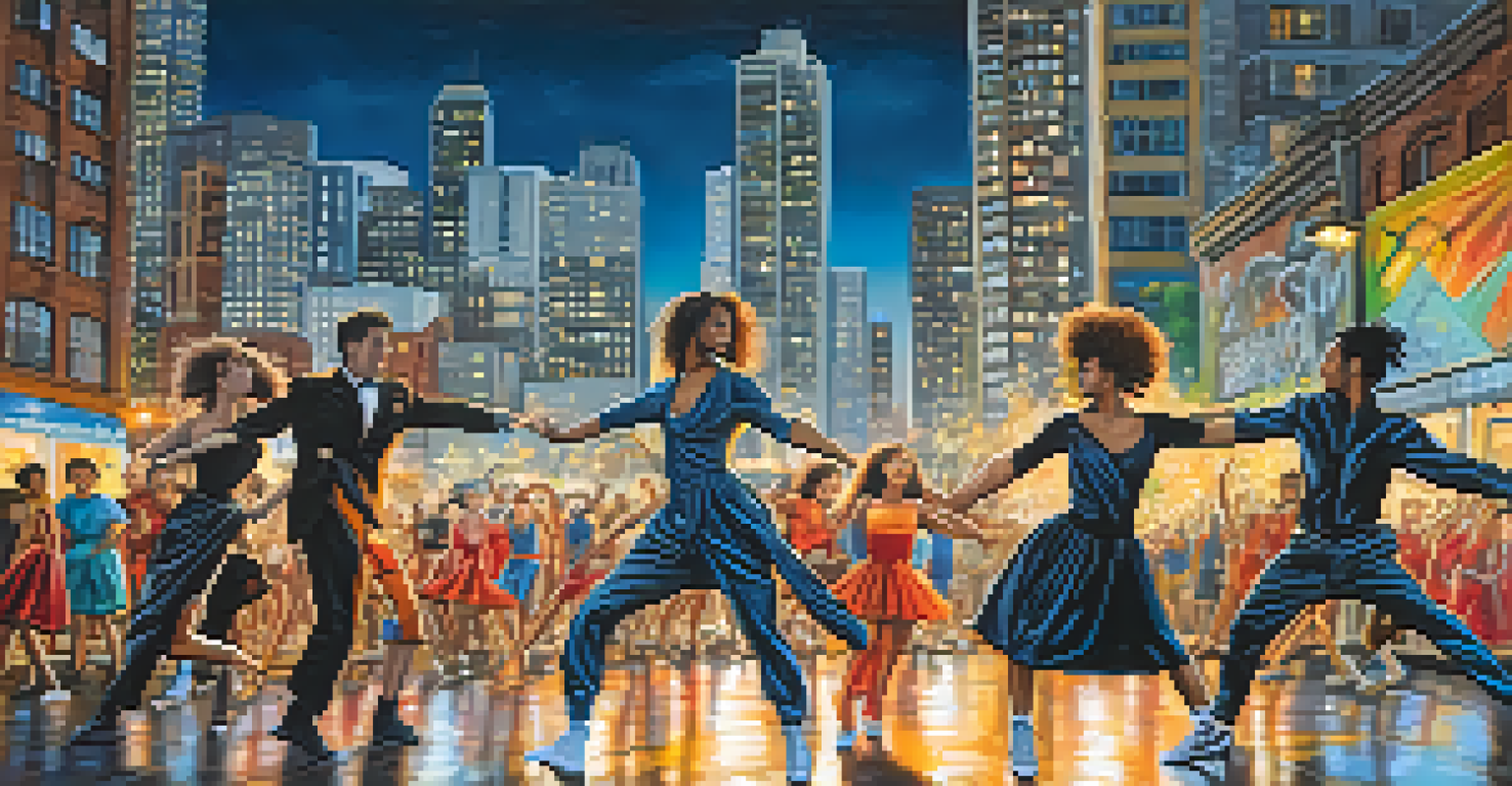Environmental Themes in Contemporary Dance: An Overview

The Intersection of Dance and Environmental Awareness
Contemporary dance has evolved into a powerful medium for environmental advocacy. Choreographers and dancers are using their art to highlight pressing ecological issues, blending movement with messages about climate change and sustainability. This intersection of art and activism not only engages audiences but also prompts them to reflect on their own relationship with the environment.
Dance is the hidden language of the soul.
By incorporating natural elements and themes into their performances, dancers create a visceral connection between the audience and the planet. For instance, a dance piece that mimics the flowing movements of water can evoke thoughts about pollution and conservation. Such creative expressions serve as a reminder of the beauty of nature and the urgent need to protect it.
Moreover, these performances often take place in unconventional settings, such as parks or urban landscapes, further emphasizing the connection to the environment. This approach not only enhances the aesthetic experience but also encourages viewers to consider the spaces they inhabit and their impact on the world around them.
Choreographic Techniques Highlighting Environmental Issues
Choreographers are increasingly employing innovative techniques to convey environmental themes through movement. One common method is the use of physical language that mirrors natural phenomena, like the sway of trees in the wind or the rhythm of ocean waves. Such movements can evoke a sense of harmony with nature, while simultaneously addressing how human actions disrupt this balance.

Additionally, dancers often utilize props made from recycled materials, which not only adds a visual component but also reinforces the message of sustainability. For example, a dance involving costumes crafted from plastic waste can provide a stark visual reminder of pollution's impact. This approach not only captivates the audience but also sparks conversations about waste and responsible consumption.
Dance as a Medium for Advocacy
Contemporary dance effectively combines artistic expression with environmental advocacy, prompting audiences to reflect on ecological issues.
Furthermore, the integration of multimedia elements, such as projections of environmental footage, enhances the storytelling aspect of the dance. These visual aids create a more immersive experience, allowing audiences to witness the beauty and fragility of nature in real time, thereby deepening their emotional connection to the message.
Notable Works Championing Environmental Causes
Several contemporary dance pieces have gained recognition for their strong environmental themes. For instance, 'The Climate Change Dance' by choreographer Andrea Miller combines powerful movement with striking visuals to raise awareness about global warming. Each performance is a call to action, urging audiences to reflect on their roles in the crisis.
Art is not freedom from discipline, but disciplined freedom.
Another noteworthy work is 'Earth Moves' by the acclaimed company Dance Theatre of Ireland, which explores the delicate balance of ecosystems through intricate choreography. The dancers' movements mimic the interconnectedness of nature, making the audience acutely aware of the fragility of our planet's resources.
These performances not only entertain but also educate, leaving a lasting impression on viewers. They serve as a reminder that art can be a catalyst for change, inspiring individuals to take steps toward a more sustainable future.
The Role of Dance in Climate Activism
Dance has emerged as an influential tool in the realm of climate activism, using the power of movement to galvanize action. Many dancers and choreographers collaborate with environmental organizations, participating in campaigns that raise awareness and advocate for policy changes. This partnership highlights the potential of the arts to engage communities in critical discussions about our planet's future.
Through performances, flash mobs, and public demonstrations, dancers are able to reach diverse audiences, often igniting a sense of urgency around environmental issues. For example, large-scale dance events in urban centers can attract media attention and spark public interest in sustainability initiatives. These efforts showcase the unique ability of dance to cross cultural and social boundaries.
Innovative Techniques in Choreography
Choreographers are using physical language and multimedia elements to convey environmental themes, enhancing the emotional impact of their performances.
Moreover, the emotional resonance of dance can foster a deeper understanding of ecological crises. When audiences witness the passion and commitment of dancers advocating for the environment, they are more likely to reflect on their own actions and consider how they can contribute to positive change.
Community Engagement Through Dance and Environment
Contemporary dance often thrives on community engagement, making it an ideal platform for environmental education. Dance companies frequently host workshops and outreach programs that bring together dancers and local communities to explore environmental themes. These interactive experiences not only empower participants but also foster a sense of shared responsibility for the planet.
By involving community members in the creative process, dancers can inspire collective action towards environmental issues. For instance, a community dance project might focus on a local environmental concern, such as deforestation or pollution, allowing participants to express their thoughts and feelings through movement. This collaborative approach promotes awareness and encourages dialogue about solutions.
Additionally, such initiatives can help to bridge the gap between art and activism, making environmental issues more relatable and accessible. When individuals see their own experiences reflected in dance, they are more likely to engage with both the art form and the underlying message, creating a ripple effect of awareness and activism.
The Impact of Technology on Environmental Dance Themes
In today's digital age, technology plays a significant role in shaping contemporary dance, especially in relation to environmental themes. Choreographers are increasingly incorporating digital media, such as video projections and interactive installations, to enhance their performances. This integration allows for a more dynamic exploration of environmental issues, captivating audiences and enriching the overall experience.
For example, a performance might feature projections of melting ice caps or deforested landscapes, reinforcing the urgency of climate change. By using technology to visualize these concepts, dancers can create a more profound emotional impact, encouraging viewers to reflect on the consequences of their actions. This blend of art and technology opens new avenues for storytelling.
Community Engagement through Dance
Dance initiatives often involve local communities in exploring environmental themes, fostering collective action and awareness.
Furthermore, social media has become a vital tool for promoting environmental dance initiatives. Dancers can share their work online, reaching a wider audience and inspiring others to join the conversation. This digital engagement fosters a sense of community among artists and activists, amplifying their collective efforts for a sustainable future.
Future Directions for Environmental Themes in Dance
As we look to the future, the integration of environmental themes in contemporary dance is likely to expand even further. With climate change and ecological degradation becoming increasingly urgent issues, artists will continue to find innovative ways to express their concerns through movement. This evolving dialogue will not only enrich the art form but also galvanize audiences into action.
Emerging choreographers are already experimenting with new styles and approaches that reflect the complexities of our relationship with nature. The use of site-specific performances, for instance, allows dancers to engage with their surroundings in ways that highlight local environmental issues. This trend emphasizes the importance of context, making each performance unique and relevant.

Ultimately, the future of dance as a vehicle for environmental advocacy looks promising. By harnessing the emotional power of movement and the creativity of artists, contemporary dance can continue to inspire change, encourage dialogue, and nurture a deeper connection to the world we inhabit.